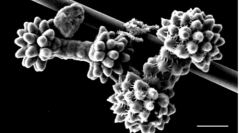

 Zoosystema
22 (2) - Pages 337-344
Zoosystema
22 (2) - Pages 337-344Revision of families in the order Hadromerida (Porifera, Demospongiae) makes it necessary to establish two new genera. In the family Placospongiidae, the genus Amphinolana is introduced for a new species, A. claudelevii, from the Great Barrier Reef, Australian West Pacific. It is the second genus in the family and distinguished by the presence of cortical and choanosomal, dumbbell-shaped sterrasters which derive from an amphiaster-like microsclere and are termed amphinolasters. The other spicules of Amphinolana claudelevii include small microspined spirasters and the usual megascleres (tylostyles). In the family Clionidae, the genus Cervicornia is named to accommodate Alcyonium cuspidiferum Lamarck, previously placed in Spirastrella and Spheciospongia. This genus is separated from other clionids by large (up to 30 cm tall), ectosomal inhalant fistules and a pulp-like endopsammic choanosome. Cervicornia cuspidifera generates an unusual flow-direction of water which is taken in through its epibenthic, blind-ending fistules and exhaled through the coarse sand substrate.
Porifera, new species, Amphinolana claudelevii, Placospongia, Clionidae, Cervicornia cuspidifera, selenaster, amphinolaster.